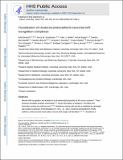| dc.contributor.author | Brasch, Julia | |
| dc.contributor.author | Goodman, Kerry M. | |
| dc.contributor.author | Noble, Alex J. | |
| dc.contributor.author | Rapp, Micah | |
| dc.contributor.author | Mannepalli, Seetha | |
| dc.contributor.author | Bahna, Fabiana | |
| dc.contributor.author | Dandey, Venkata P. | |
| dc.contributor.author | Bepler, Tristan | |
| dc.contributor.author | Berger Leighton, Bonnie | |
| dc.contributor.author | Maniatis, Tom | |
| dc.contributor.author | Potter, Clinton S. | |
| dc.contributor.author | Carragher, Bridget | |
| dc.contributor.author | Honig, Barry | |
| dc.contributor.author | Shapiro, Lawrence | |
| dc.date.accessioned | 2019-11-13T18:38:25Z | |
| dc.date.available | 2019-11-13T18:38:25Z | |
| dc.date.issued | 2019-04-10 | |
| dc.date.submitted | 2018-07 | |
| dc.identifier.issn | 0028-0836 | |
| dc.identifier.issn | 1476-4687 | |
| dc.identifier.uri | https://hdl.handle.net/1721.1/122924 | |
| dc.description.abstract | Neurite self-recognition and avoidance are fundamental properties of all nervous systems. These processes facilitate dendritic arborization, prevent formation of autapses and allow free interaction among non-self neurons. Avoidance among self neurites is mediated by stochastic cell-surface expression of combinations of about 60 isoforms of α-, β- and γ-clustered protocadherin that provide mammalian neurons with single-cell identities. Avoidance is observed between neurons that express identical protocadherin repertoires2,5, and single-isoform differences are sufficient to prevent self-recognition10. Protocadherins form isoform-promiscuous cis dimers and isoform-specific homophilic trans dimers. Although these interactions have previously been characterized in isolation, structures of full-length protocadherin ectodomains have not been determined, and how these two interfaces engage in self-recognition between neuronal surfaces remains unknown. Here we determine the molecular arrangement of full-length clustered protocadherin ectodomains in single-isoform self-recognition complexes, using X-ray crystallography and cryo-electron tomography. We determine the crystal structure of the clustered protocadherin γB4 ectodomain, which reveals a zipper-like lattice that is formed by alternating cis and trans interactions. Using cryo-electron tomography, we show that clustered protocadherin γB6 ectodomains tethered to liposomes spontaneously assemble into linear arrays at membrane contact sites, in a configuration that is consistent with the assembly observed in the crystal structure. These linear assemblies pack against each other as parallel arrays to form larger two-dimensional structures between membranes. Our results suggest that the formation of ordered linear assemblies by clustered protocadherins represents the initial self-recognition step in neuronal avoidance, and thus provide support for the isoform-mismatch chain-termination model of protocadherin-mediated self-recognition, which depends on these linear chains. Keywords: cryoelectron tomography; molecular neuroscience; x-ray crystallography | en_US |
| dc.description.sponsorship | National Institutes of Health (U.S.) (Grant R01GM081871) | en_US |
| dc.language.iso | en | |
| dc.publisher | Springer Science and Business Media LLC | en_US |
| dc.relation.isversionof | http://dx.doi.org/10.1103/10.1038/s41586-019-1089-3 | en_US |
| dc.rights | Article is made available in accordance with the publisher's policy and may be subject to US copyright law. Please refer to the publisher's site for terms of use. | en_US |
| dc.source | PMC | en_US |
| dc.title | Visualization of clustered protocadherin neuronal self-recognition complexes | en_US |
| dc.type | Article | en_US |
| dc.identifier.citation | Brasch, J., et al. "Visualization of clustered protocadherin neuronal self-recognition complexes." Nature 569, 7755 (May 2019): 280–283 © 2019 Springer Nature Limited | en_US |
| dc.contributor.department | Massachusetts Institute of Technology. Department of Mathematics | en_US |
| dc.contributor.department | Massachusetts Institute of Technology. Computational and Systems Biology Program | en_US |
| dc.contributor.department | Massachusetts Institute of Technology. Computer Science and Artificial Intelligence Laboratory | en_US |
| dc.relation.journal | Nature | en_US |
| dc.eprint.version | Author's final manuscript | en_US |
| dc.type.uri | http://purl.org/eprint/type/JournalArticle | en_US |
| eprint.status | http://purl.org/eprint/status/PeerReviewed | en_US |
| dc.date.updated | 2019-11-07T18:01:08Z | |
| dspace.date.submission | 2019-11-07T18:01:14Z | |
| mit.journal.volume | 569 | en_US |
| mit.journal.issue | 7755 | en_US |

